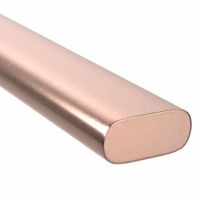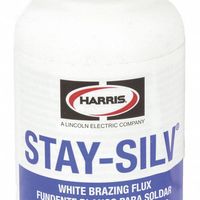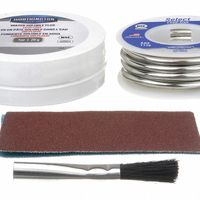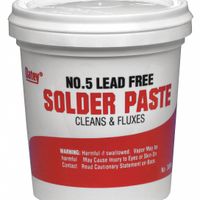Call +(254) 703 030 000 / 751 483 999 / 721 704 777
- Home
- Welding
- Filler Metals
- Brazing Soldering Filler Metals
.....Read More
Frequently Asked Questions
What is the difference between brazing and soldering?
Brazing and soldering are both metal-joining processes that use a filler metal to bond two or more metal parts without melting the base materials. However, they differ in several key aspects:
1. **Temperature**: The primary difference lies in the temperature at which each process operates. Brazing occurs at temperatures above 450°C (842°F), while soldering takes place below this threshold. The higher temperature in brazing results in stronger joints compared to soldering.
2. **Filler Material**: In brazing, the filler metal typically has a higher melting point than that used in soldering. Common brazing fillers include alloys of silver, copper, and aluminum, whereas soldering often uses tin-lead or lead-free alloys.
3. **Joint Strength**: Due to the higher temperatures and stronger filler materials, brazed joints are generally stronger and more durable than soldered ones. This makes brazing suitable for applications requiring high strength and resistance to stress.
4. **Applications**: Brazing is often used in industries such as aerospace, automotive, and HVAC for joining dissimilar metals and components that require high strength. Soldering is commonly used in electronics, plumbing, and jewelry for its precision and lower thermal impact on components.
5. **Capillary Action**: Both processes rely on capillary action to distribute the molten filler metal between closely fitted parts. However, the effectiveness of capillary action is more pronounced in brazing due to the higher fluidity of the filler at elevated temperatures.
6. **Flux Usage**: Both processes use flux to prevent oxidation and improve wetting. However, the type and composition of flux can vary, with brazing often requiring more robust fluxes to withstand higher temperatures.
In summary, the main differences between brazing and soldering are the operating temperatures, filler materials, joint strength, and typical applications, with brazing generally providing stronger and more heat-resistant joints.
What are the common applications of brazing and soldering?
Brazing and soldering are widely used in various industries due to their ability to join metals without melting the base materials. Here are common applications for each:
**Brazing:**
1. **HVAC Systems:** Brazing is used to join copper and aluminum components in air conditioning and refrigeration systems, ensuring leak-proof and durable joints.
2. **Automotive Industry:** It is employed in the manufacturing of radiators, fuel injectors, and other components where strong, heat-resistant joints are required.
3. **Aerospace:** Brazing is used to join high-strength alloys and superalloys in turbine engines and other critical components, providing reliable performance under extreme conditions.
4. **Plumbing:** Copper pipes and fittings are often joined using brazing, providing strong, corrosion-resistant joints that can withstand high pressures and temperatures.
5. **Electrical Industry:** Brazing is used to join electrical contacts and components, ensuring good conductivity and mechanical strength.
**Soldering:**
1. **Electronics:** Soldering is essential in assembling printed circuit boards (PCBs), connecting electronic components with precision and reliability.
2. **Jewelry Making:** Soldering is used to join precious metals, allowing for intricate designs and repairs without damaging the materials.
3. **Plumbing:** Soft soldering is used for joining copper pipes in domestic water systems, providing leak-proof joints at lower temperatures.
4. **Stained Glass:** Soldering is used to join pieces of glass with lead or copper foil, creating decorative and functional art pieces.
5. **Musical Instruments:** Soldering is used in the assembly and repair of brass and woodwind instruments, ensuring airtight and durable joints.
Both brazing and soldering offer advantages such as low thermal distortion, the ability to join dissimilar metals, and cost-effectiveness, making them indispensable in various manufacturing and repair applications.
What types of filler metals are used in brazing and soldering?
In brazing, filler metals typically have a melting point above 450°C (842°F) and are often composed of alloys such as silver, copper, aluminum, or nickel. Silver-based alloys, known as silver brazing alloys, are popular due to their excellent flow characteristics and strong joint formation. Copper-based alloys are used for their high-temperature resistance and are common in HVAC applications. Aluminum brazing alloys are used for joining aluminum parts, while nickel-based alloys are chosen for their corrosion resistance and strength at high temperatures.
In soldering, filler metals, known as solders, have a melting point below 450°C (842°F). The most common solders are tin-based, often alloyed with lead, silver, or copper. Traditional tin-lead solders (e.g., 60/40 or 63/37 tin-lead) are widely used due to their low melting point and good wetting properties. However, due to health and environmental concerns, lead-free solders, such as tin-silver-copper (SAC) alloys, have become prevalent, especially in electronics. Other solder types include tin-copper for plumbing and tin-zinc for aluminum soldering.
Both brazing and soldering filler metals are selected based on factors like the base materials being joined, the required joint strength, operating conditions, and regulatory requirements.
How do you choose the right flux for brazing or soldering?
To choose the right flux for brazing or soldering, consider the following factors:
1. **Base Metals**: Identify the metals being joined. Different metals require specific fluxes to effectively remove oxides and promote wetting. For example, aluminum requires a different flux than copper.
2. **Filler Material**: Match the flux to the filler material. Some fluxes are designed to work with specific solder or brazing alloys, ensuring optimal performance.
3. **Temperature Range**: Ensure the flux is suitable for the operating temperature of the process. Soldering typically occurs at lower temperatures than brazing, so the flux must be stable and active at the required temperature.
4. **Flux Form**: Choose between paste, liquid, or powder forms based on application needs. Paste fluxes are often used for precision work, while liquid fluxes can be applied more broadly.
5. **Residue**: Consider the post-process cleaning requirements. Some fluxes leave corrosive residues that must be cleaned, while others are no-clean and leave minimal residue.
6. **Activity Level**: Select the appropriate activity level based on the cleanliness of the metals. Highly active fluxes are needed for heavily oxidized surfaces, while less active fluxes suffice for clean surfaces.
7. **Environmental and Safety Concerns**: Be aware of any hazardous materials in the flux and ensure compliance with safety regulations. Opt for fluxes with minimal environmental impact when possible.
8. **Application Method**: Consider how the flux will be applied. Some processes may require dipping, brushing, or spraying, influencing the choice of flux form and viscosity.
By evaluating these factors, you can select a flux that ensures strong, reliable joints while meeting the specific requirements of your brazing or soldering application.
What are the advantages of brazing over welding?
Brazing offers several advantages over welding:
1. **Lower Temperature**: Brazing occurs at lower temperatures than welding, reducing the risk of warping, distortion, or altering the properties of the base metals. This is particularly beneficial for thin-walled or delicate components.
2. **Material Compatibility**: Brazing can join dissimilar metals and non-metals, such as ceramics, which is often challenging with welding. This versatility allows for more diverse applications.
3. **Uniform Heating**: The process provides more uniform heating, which results in less thermal stress and a more consistent joint quality across the entire workpiece.
4. **Aesthetic Finish**: Brazed joints are typically cleaner and more aesthetically pleasing, requiring less post-process finishing compared to welded joints.
5. **Complex Assemblies**: It is well-suited for joining complex assemblies and intricate parts, as it can reach areas that are difficult to access with welding.
6. **Reduced Oxidation**: The use of flux or protective atmospheres in brazing minimizes oxidation, preserving the integrity and appearance of the joint.
7. **Cost-Effective**: Brazing can be more cost-effective due to lower energy consumption and reduced need for expensive equipment and skilled labor compared to welding.
8. **Mechanical Properties**: The process maintains the mechanical properties of the base metals, as it does not melt them, preserving their strength and integrity.
9. **Repeatability and Automation**: Brazing is highly repeatable and can be easily automated, making it suitable for high-volume production environments.
10. **Minimal Distortion**: The lower heat input results in minimal distortion, which is crucial for maintaining tight tolerances in precision applications.
These advantages make brazing an attractive option for many industrial applications, particularly where precision, material compatibility, and aesthetic considerations are paramount.
How do you ensure a strong joint in brazing or soldering?
To ensure a strong joint in brazing or soldering, follow these key steps:
1. **Material Selection**: Choose compatible base metals and filler materials. The filler should have a melting point lower than the base metals but high enough to withstand service conditions.
2. **Surface Preparation**: Clean the surfaces to be joined thoroughly. Remove oxides, oils, and contaminants using mechanical methods (e.g., wire brushing) or chemical cleaning (e.g., solvents or acid baths).
3. **Proper Fit and Clearance**: Ensure the parts fit well with appropriate clearance. For brazing, a gap of 0.001 to 0.005 inches is ideal, while soldering requires a tighter fit.
4. **Flux Application**: Apply the correct flux to prevent oxidation during heating. Flux should match the filler material and be applied evenly to the joint area.
5. **Heating Method**: Use a suitable heating method (torch, furnace, induction) to evenly heat the joint area. Avoid overheating, which can weaken the joint or damage the base metals.
6. **Filler Application**: Introduce the filler material once the joint reaches the appropriate temperature. Capillary action should draw the filler into the joint. Ensure complete coverage for a strong bond.
7. **Cooling**: Allow the joint to cool naturally to avoid thermal shock. Rapid cooling can lead to cracks or weakened joints.
8. **Post-Cleaning**: Remove any residual flux, as it can be corrosive. Use water, solvents, or mechanical methods depending on the flux type.
9. **Inspection**: Inspect the joint for defects such as voids, incomplete coverage, or misalignment. Use visual inspection, X-ray, or other non-destructive testing methods.
10. **Testing**: Perform mechanical testing if necessary to ensure the joint meets strength requirements.
By following these steps, you can achieve a strong, reliable joint in brazing or soldering applications.
What safety precautions should be taken during brazing and soldering?
During brazing and soldering, several safety precautions are essential to ensure a safe working environment:
1. **Personal Protective Equipment (PPE):** Wear safety goggles or a face shield to protect eyes from sparks and intense light. Use heat-resistant gloves to prevent burns from hot metals and tools. Wear a long-sleeved, flame-resistant apron or clothing to protect skin from heat and molten metal.
2. **Ventilation:** Ensure adequate ventilation in the workspace to avoid inhaling fumes. Use local exhaust ventilation systems or fume extractors to remove hazardous fumes and gases produced during the process.
3. **Fire Safety:** Keep a fire extinguisher nearby, specifically one suitable for metal fires. Clear the area of flammable materials and ensure a fire blanket is accessible. Be aware of your surroundings and have an emergency plan in place.
4. **Equipment Safety:** Regularly inspect and maintain equipment to prevent leaks or malfunctions. Use the correct tools and equipment for the specific brazing or soldering task. Ensure that gas cylinders are stored upright and secured to prevent tipping.
5. **Work Area Organization:** Keep the work area clean and organized to prevent accidents. Ensure that all tools and materials are within easy reach and that the workspace is free of clutter.
6. **Training and Awareness:** Ensure that all personnel involved in brazing and soldering are adequately trained in the processes and safety procedures. Stay informed about the materials being used and their potential hazards.
7. **Handling Chemicals:** Be cautious when handling fluxes and other chemicals. Follow the manufacturer's instructions and safety data sheets (SDS) for proper handling, storage, and disposal.
8. **First Aid:** Have a first aid kit readily available and ensure that personnel are trained in basic first aid procedures, particularly for treating burns and inhalation injuries.





